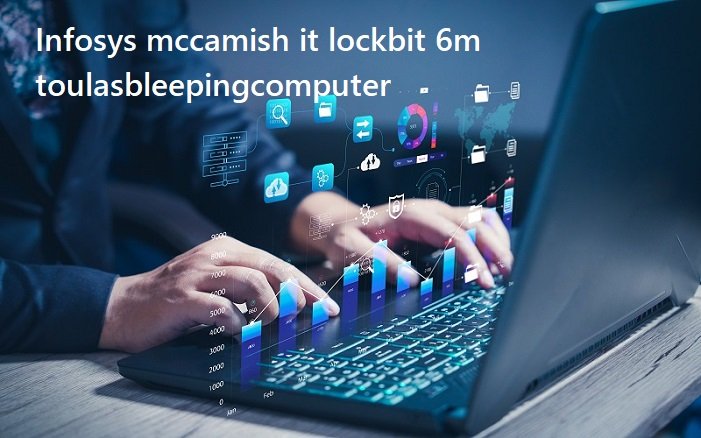Infosys McCamish Targeted by LockBit Ransomware: $6M Hack Shocks IT Industry

Having followed cybersecurity threats closely for years, I can confidently say that the recent attack on Infosys McCamish by the LockBit ransomware group is one of the most concerning breaches of 2024.
LockBit, notorious for its relentless ransomware attacks, has once again struck, and this time the target is a significant player in the IT world.
What’s at stake? A $6 million ransom and potentially sensitive data that could harm both McCamish and its clients.
Here’s everything you need to know about this breach and what it means for the IT and insurance sectors.
What Happened: Infosys McCamish Hit by LockBit’s $6M Ransom Demand
LockBit is back at it again, and this time they’ve managed to breach the systems of Infosys McCamish, a subsidiary of Infosys that provides insurance and IT solutions.
The hackers infiltrated the company’s systems and are now demanding a $6 million ransom to prevent the release of sensitive data.
This is huge, especially given the reputation of Infosys as one of the world’s leading IT service providers. It’s a stark reminder that no matter how secure a system may seem, ransomware groups like LockBit are constantly evolving and finding new vulnerabilities to exploit.
How Did LockBit Breach Infosys McCamish?
While there aren’t a lot of details publicly available about how LockBit managed to get inside McCamish’s IT infrastructure, based on my experience, the attack likely exploited a vulnerability in their systems or possibly targeted a third-party application that wasn’t fully secure.
LockBit is known for using highly sophisticated phishing schemes, zero-day vulnerabilities, or brute-force attacks. I’ve seen companies hit before due to misconfigured systems or unpatched software, and that could have been the entry point here as well.
BleepingComputer Leak: Infosys McCamish Data Threatened
According to reports by BleepingComputer, a well-regarded site in the cybersecurity space, LockBit has already begun threatening to release the stolen data if their ransom is not paid.
This could potentially involve a lot of sensitive information, especially given McCamish’s role in insurance IT services.
The consequences of such a leak would be devastating not only for McCamish but for the clients who rely on their services.
Confidential customer data, financial records, and proprietary systems could be exposed, leading to massive legal and financial repercussions.
Why This Attack Matters for the IT and Insurance Sectors
As someone who works in the IT industry, I can tell you that this breach is a major wake-up call. Infosys McCamish is no small player—they’re responsible for handling data and systems for insurance companies across the globe.
A breach of this scale shows that no company is completely safe from the sophisticated tactics employed by modern ransomware groups.
Here are the major takeaways:
- No Company Is Immune: Infosys is a global giant in IT services, yet even their security systems were vulnerable. If it can happen to them, it can happen to anyone.
- Third-Party Vulnerabilities: Even if your internal systems are strong, breaches can happen through vulnerabilities in third-party software or partners. Ensuring every part of your IT infrastructure is secure is essential.
- The Rise of Double Extortion: LockBit’s model isn’t just about encrypting data anymore. They also threaten to leak sensitive information, a tactic known as double extortion. The damage goes beyond just downtime—it’s about reputation, legal consequences, and customer trust.
The Growing Threat of LockBit Ransomware
LockBit is one of the fastest-growing ransomware groups, and their “Ransomware-as-a-Service” (RaaS) model makes it even more dangerous.
Affiliates can use the LockBit software to carry out attacks in exchange for a portion of the ransom, which means that LockBit’s reach extends far beyond just one group of hackers.
In the case of Infosys McCamish, LockBit’s tactics are more aggressive than ever. The version they’re using, LockBit 3.0, is highly advanced, with stronger encryption algorithms and more effective methods of bypassing security measures.
This version is designed to make it harder for companies to recover without paying the ransom, which is why they’ve become such a formidable force in the ransomware world.
What Happens Next for Infosys McCamish?
Right now, Infosys McCamish is likely in full damage control mode. The decision to pay the ransom or not is never an easy one.
Many companies try to avoid paying, as there’s no guarantee the hackers won’t leak the data or hit them again in the future. However, the alternative—having sensitive data leaked—can be even more disastrous.
In the meantime, cybersecurity experts around the globe are watching closely to see how this situation unfolds. The attack on Infosys McCamish is likely to serve as a case study for how major IT companies respond to ransomware threats moving forward.
Lessons Learned: How to Protect Against Ransomware Attacks
This attack on Infosys McCamish is a stark reminder that we all need to stay vigilant. Whether you’re working in IT, managing a business, or just protecting your personal data, the threat of ransomware is very real. Here’s what I’ve learned from this incident and others like it:
- Regular Software Updates: Make sure your systems are always up to date with the latest patches. Ransomware groups often exploit known vulnerabilities that haven’t been patched yet.
- Backup Systems: Have a solid backup system in place. That way, if your systems are compromised, you can restore your data without paying the ransom.
- Employee Training: Many ransomware attacks start with phishing emails. Training your employees to recognize suspicious emails and links can go a long way in preventing a breach.
- Third-Party Risk Management: Ensure that all third-party vendors follow strict security protocols. A breach through one of their systems can open the door to your company’s data.
Final Thoughts
The attack on Infosys McCamish is a sobering reminder that ransomware is not going anywhere. LockBit and similar groups are becoming more advanced, and the costs of these attacks—both financial and reputational—are skyrocketing.
If you work in IT or run a business that handles sensitive data, now is the time to double down on cybersecurity measures.
Don’t wait for an attack to happen; proactively safeguard your systems, train your employees, and always be prepared for the worst-case scenario.
Have any thoughts or questions on this attack or ransomware in general? Drop a comment below, and let’s discuss how we can protect ourselves in this ever-changing digital landscape!





